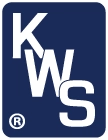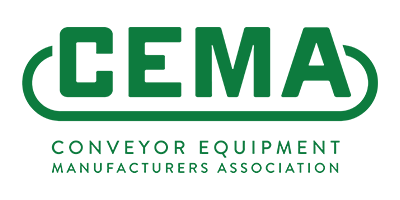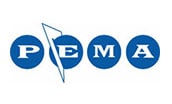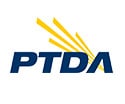Shaftless Screw Conveyor Capacity & Horsepower Calculations
Shaftless Conveyor Calculations
The following information provides the basic criteria for calculating capacity, horsepower, torsional rating, and deflection. These calculations are critical to the design of a successful shaftless conveyor.
Capacity Calculation
The specified capacity can easily be calculated by dividing the material capacity given in pounds per hour by the density of the bulk material being conveyed. The capacity is given in cubic feet per hour.
Shaftless screw conveyor capacity is calculated using the spiral diameter, spiral pitch, trough loading percentage, degree of incline (if any) and spiral rotational speed. The required speed is then calculated by dividing the required material flow rate by the capacity per revolution. “D” and “d” are the outer and inner diameters of the spiral. “I” and “R” are factors related to the incline and the nature of shaftless conveyors. The remaining variables ensure that the units are converted correctly.

The required shaftless screw conveyor speed can then be calculated from the results obtained above.
Shaftless screw conveyors are most efficient at lower speeds and the acceptable speed range is typically between 20 and 40-rpm. If the calculated speed of the conveyor is outside the recommended speed range, change the trough loading or conveyor diameter to manipulate the speed to stay within the acceptable speed range.
To simplify calculations and promote the use of standardized components, KWS shaftless conveyors use standard nominal size spirals with full, 2/3 or 1/2 pitch. KWS can design to special spiral diameters and pitches upon Customer request.
Horsepower Calculation
Now that capacity, screw conveyor diameter, trough loading and required speed have been determined, the next task is to calculate the horse power requirements for the conveyor. Conveyor Length, which has not been considered a factor up to this point, now plays a pivotal role. The following equation makes use of the speed, trough loading, conveyor length, drive efficiency and material factor.
Demand horsepower of the shaftless screw conveyor is calculated in two parts. First, the horsepower to turn the conveyor empty, or the Friction Horsepower is calculated. Then, the horsepower required to move the material, or the Material Horsepower is calculated. Empirical factors like Fd and Fb have been developed by KWS through years of experience and testing of bulk materials. These factors help account for conveyor size, incline, bearing load, material conditions, special features, and non-linear flow conditions.
Most screw conveyor drives are considered to be 88-percent efficient due to a combination of motor and gearbox efficiencies. KWS encourages the use of high efficiency drives, but does not recommend calculating Total Horsepower with a drive efficiency greater than 93-percent because it can lead to undersized drives and components.
KWS recommends the use of AGMA Class II gear reducers with a minimum service factor of 1.4 for all screw conveyor design. The service factor does not affect the efficiency or output of the gear reducer, rather it is a rating of the quality, durability and longevity of the gearing. Most screw conveyor applications are adequately covered by the AGMA Class II rating. Lower rated gear reducers will be sources of frequent maintenance and replacement.
Torsional Rating Calculations
KWS designs every shaftless screw conveyor to withstand the forces generated by the full motor torque of the drive. Drive shaft diameter, flange bolt rating and the torsional rating of the spiral will be checked according to the following calculations.
Full Motor Torque is calculated using the Total Horsepower and Speed of the drive. The following calculation represents the full motor torque as measured at the output shaft of the gearbox.
The suitability of the drive shaft is determined by comparing the Safe Stress of the material to the applied stress at Full Motor Torque. Without diving into the excruciating details of material failure modes and machine design theory, the safe stress of a material is approximately 20-percent of the yield strength of the material. The yield strengths of common materials are widely published and easily compared. Material selection can affect the safe stress rating of the drive shaft, coupling bolts and spiral.
KWS connects the one-piece flanged drive shaft to the spiral flange using six flange bolts. The flange bolts transmit the torque of the drive from the drive shaft to the spiral. Because the shaftless spiral is fully supported by wear liner, the coupling bolts do not carry the weight of the spiral. Only the shearing stress of the bolts must be calculated.
If the flange bolts are found to be inadequate, then higher strength flange bolts can be used. The number and size of the flange bolts usually result in a very large safety factor when compared to full motor torque. As a general rule, if there seems to be an issue with the Safe Bolt Torque Rating, then design would need to be revisited.
The shaftless spiral is a large diameter, high strength spring that must also transmit the Full Motor Torque of the drive. The primary factor that affects the torque rating of the spiral is the material of construction. The inner spiral, if used, does not contribute any torsional support because it cannot be effectively welded to the drive plate. At this point, the complexity of the torsional calculations increases significantly, so the following equations reflects only the approval criteria.
If Full Motor Torque is less than the Safe Torque Rating of the Spiral, then the spiral is appropriately sized and the material of construction of the spiral is acceptable. Of course, the material of construction of the spiral may be chosen based on other factors like resistance to abrasion or corrosion. Please contact KWS for assistance in selecting the spiral material right for your application.
Spiral Deflection Calculation
The shaftless spiral will stretch or compress when placed under load. The technical term for this stretching or compression is Deflection. If the drive unit is placed on the discharge end of the screw conveyor, the spiral will stretch. The spiral will compress if the drive unit is located on the inlet end. The two main loads causing deflection are the weight of the spiral and the load of the bulk material as it is conveyed. Naturally, a strong contributor to the deflection of the spiral is the incline of the conveyor, because the weight of the spiral will cause the spiral to deflect. All other deflection is a result of the bulk material being conveyed. Unlike the torque calculation, the inner spiral helps reduce the deflection of the spiral.
Similarly to the Safe Torque Rating of the Spiral, the Spiral Deflection is an extremely complicated calculation that has been simplified to the approval criteria.
Typically, only extremely long horizontal shaftless screw conveyors will see significant spiral deflection. Inclined and vertical shaftless conveyors also tend to have greater deflection when compared to horizontal shaftless screw conveyors of the same length.
Every KWS Shaftless Screw Conveyor is designed for long life and minimal downtime using the calculations described above.





